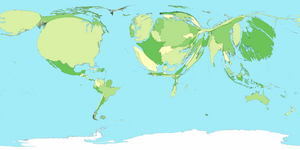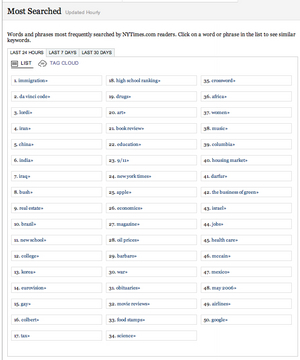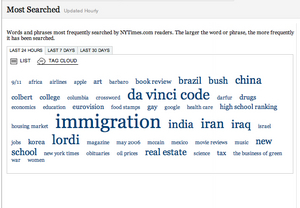The End of Empire: IBM, OpenDocument, and Enterprise Monocultures
IBM recently announced the next version of Lotus Notes will support OpenDocument Format as a native file format (as reported in IBM Bets Big On Open Source In Next Release Of Lotus Notes). This shift to an open file format is – as the majority of the coverage of IBM’s announcement correctly interprets it to be – a direct challenge to the dominance of the Office suite of productivity applications, a class of products in which Microsoft has long relied on proprietary file formats as a cornerstone of it’s market control strategy. Making the challenge explicit, the next version of Lotus Notes will also include “…built-in word processing, spreadsheet, and presentation graphics software”.
Since Microsoft relies on the integration of SharePoint and the Office suite as a pillar of it’s collaboration plans (in Gates outlines SharePoint strategy, hammers IBM, John Fontana of Network World quotes Bill Gates as saying, “The key point is that SharePoint is becoming the key platform for collaboration of all types… When people look back on what we are doing with Office [2007] here, the most revolutionary element will be what we are doing with SharePoint.”), IBM’s shift to OpenDocument Format is also a strategic move in the larger category of enterprise collaboration, itself a subset of the emerging comprehensive information working environments Forrester Research calls the information workplace.
An End to Imperialism
I’ve suggested already that the conceptual construct labeled ‘collaboration’ is at heart another instance of enterprise software and solution vendor marketing rhetoric designed to mask reality – it’s simply not possible to change established cultural, organizational, perceptual, or philosophical understandings of what work is and how it should be done with an approach centered on technology – in a quasi-utopian haze.
IBM’s adoption of OpenDocument doesn’t change this picture of the collaboration landscape. Instead, it indicates a larger shift; dawning recognition and acknowledgment that monocultures are no longer viable, or valid, or broadly acceptable in the enterprise arena.
The creation and preservation of monocultures (recently in the news associated with Microsoft thanks to Dan Greer and others’ prescience) is one of the salient characteristics of the old approach to enterprise software solutions. It is especially visible in those enterprise solutions whose intended role within a portfolio of product and service offerings is to serve as a consistent revenue source, strategic bulwark against competition, and cost shifting mechanism whereby clients paid for the development of new products and services, often under the guise of maintenance, patches, upgrades, etc.
Broadly, the old approach to enterprise solutions was an imperial model, with aspects of colonialism, that pursued a military style take and hold growth pattern.
Wikipedia offers the following introduction to imperialism:
“Imperialism is a policy of extending control or authority over foreign entities as a means of acquisition and/or maintenance of empires. This is either through direct territorial conquest or settlement, or through indirect methods of exerting control on the politics and/or economy of other countries. The term is often used to describe the policy of a country’s dominance over distant lands, regardless of whether the country considers itself part of the empire.”
In the realm of software imperialism, the customer organization buying and installing an enterprise software package was seen as a form of territory to be occupied or controlled by one or more hostile, rivalrous software and services vendors seeking to extract continuing revenues from their occupied possessions; revenues in the form of maintenance, support, customization, administration, or other sorts of solution upkeep and extension expenses.
Empires exerted control formally through a variety of political and economic mechanisms, and informally through influence over political, economic and cultural spheres. Wikipedia’s entry for “empire” offers some instructive parallels to the enterprise solution model:
“First, in an empire there must be a Core and a Periphery. The empire’s structure relates the core elite to the peripheral elite in a mutually beneficial fashion. Such as relationship can be established through any number of means, be they aggressive, coercise, or consensual. And while there is a vertical relationship between the core and periphery, there is a lack of substantive relations between periphery and periphery. This relationship he describes as an incomplete wheel: there are hubs and spokes, but no rim.”
The relationship of interconnected elites is easy to see in the pattern of incented sales and buying decisions; “Need tickets to that exclusive event? No problem, we’ll get them for you right away…”
But it’s the idea of disconnected hubs and spokes that is key to understanding the correspondence between the old enterprise model and imperialism. How often do individual client solutions (perhaps for different departments or business units) interact with each other? How often do instances of the same solution for different clients allow effective interaction between different clients of the same vendor? How often do different products nominally part of ‘integrated’ solution sets that were in actuality assembled by aggregating the offerings of acquired companies successfully interact?
Again, without overloading the analogy, there are clear parallels between the degrees of empire and the lifecycle of enterprise solutions and vendors.
“Motyl also posits varying degrees of empire: Formal, Informal, and Hegemonic. In a formal imperial relationship, the core can appoint and dismiss peripheral elites, obviate any external agenda or policies, and directly control the internal agenda and policies.”
As a consultant, I’ve seen aggressive software and services vendors directly drive business direction, strategy, investment, and process change decisions all too often. Organizations lacking vision, effective leadership, or those entering complacency or suffering decline look to vendors for leadership by proxy, allowing or asking vendors to apply their own inappropriate frames of reference and perspectives to understand and choose courses of action in situations outside the vendor’s proper domain.
“In an informal imperial relationship, the core has influence but not control over appointing and dismissing peripheral elites, direct control over the external agenda and policies, and influence over the internal agenda and policies.”
This informal relationship is the position of the entrenched vendor that provides ‘perspective’ on many situations outside their proper domain. Vendors seeking to increase their territory within client organizations often pursue growth via this method. Alternatively, vendors will control the environment in which customers and other service providers make decisions, as in the “open API” approach wherein the enterprise exposes a portion of it’s architecture, code base, or other platform, but maintains exclusive control over the API without any binding commitments.
Wikipedia continues:
“Finally, in a hegemonic relationship, the core has no control over appointing or dismissing peripheral elites, control over the external agenda, influence over external policies, and no control over the internal agenda or policies.”
This is the stage that the existing collaboration solutions seem to be entering, as witnessed by IBM’s announcement, and Microsoft’s failure to date to advance the OpenXML standard to full legitimacy.
The Passing of Imperium
In essence, the old enterprise approach exemplified the closed system, one that was sustained by the authority and credibility of the originating vendor in the face of other competing closed systems. Fundamentally, software empires and imperialism are predicated on the validity of closed systems. What happens when open systems become the preferred model?
“Empire ends when significant peripheral interaction begins, not necessarily when the core ceases its domination of the peripheries. The core-periphery relationship can be as strong or weak as possible and remain an empire as long as there is only insignificant interaction between periphery and periphery.”
OpenDocument is designed to allow exactly the sort of periphery to periphery interaction that closed architectures prohibited. IBM’s shift to OpenDocument shows awareness that old style closed imperial enterprise systems are no longer viable. In this, they are following the changing rhetoric of those such as Larry Cannell from collaborationloop.com, who offers a strongly pro-open system view in A Vision For Collaborative Technologies:
“I believe openness breeds innovation, and there are many parts of the collaborative technology market that need a big injection of innovation. While vendors continue pushing integration as their primary value proposition for closed systems, the astute competitor will embrace openness and provide innovation within an ecosystem of collaborative technologies based on open standards. Today we have a plethora of email systems which nearly everyone connected to the Internet is capable of using. We need comparable open and simple choices for other collaborative technologies; whether it is collaborative workspaces or online communities. It will not be until we have simple open standards that foster familiarity and easy interconnectivity that will we see widespread use and explosive innovation.”
Cannell is careful here to take a positive and forward-looking line regarding collaboration, but his view of closed systems is clearly negative. And the implied consequence of a closed system is lack of innovation, one of the key signs of organizations in decline.
Didn’t I start out by saying that we should be wary of the marketing rhetoric surrounding collaboration? Yes, precisely because the majority of the rhetoric coming from enterprise vendors still exemplifies the closed system, imperialist enterprise ethos.
However, in the case of IBM, it’s clear that they’ve anticipated the consequences of ignoring the environmental shift to open systems that is at hand, and reacted accordingly, at least as regards the core document standard underlying Lotus Notes (which is still awful, BTW, just in case anyone misinterprets this article to mean I think otherwise…). The relationship of Notes to Workplace seems largely unknown at this point, and still subject to bitter infighting, in another great parallel to the imperial model. Microsoft, as the other major collaboration vendor, may be able to stem the tide against open systems in the short term, but will eventually have to respond.
My thoughts on the current form of enterprise solutions as a class / industry / way of solving business problems remain unaltered – in fact I think that IBM’s move supports many of the predictions I made earlier this year, following earlier treatments by others writing on the same subjects.









